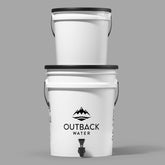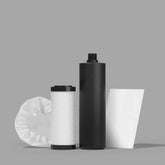The smallest organisms are our biggest concern.
The amount of bacteria on our planet is probably greater than all other organisms combined. At Outback Water, it’s our mission to remove those harmful to humans from water in order to create safe, accessible water for every man, woman and child on the planet.Bacteria basics and testing.
Bacteria are the smallest and simplest single-celled organisms that can live without a host. Despite their small size, the total weight of all bacteria in the world likely exceeds the weight of all other organisms combined. That is to say, there’s a lot of bacteria out there.
In order for bacteria to survive and grow, three things are required: nutrients, water and a source of energy. With these three ingredients, bacteria can multiply very rapidly, adapt to almost any type of environment, and can survive under some of the most extreme conditions.
Most bacteria are harmless and are even used in the production of medicines, foods and functional enzymes. But of course, the ones we’re concerned with cause disease in humans. These are referred to as pathogens, and when they’re ingested into the body they compete with normal intestinal cells for nutrients and secrete toxins that can cause a variety of symptoms and diseases.
With so many illness-causing bacteria in existence, it’s not practical to test for each of them individually. For drinking water, there are typically three types of tests performed Heterotrophic Plate Count (HPC), E. coli (a subset of fecal coliform), and Coliform (CFU).
The Heterotrophic Plate Count (HPC) method measures a broad spectrum of bacteria but can not detect the presence of any one specific pathogen. But a reading of greater than 500 Colony Forming Units (CFU) signals that corrective measures need to be taken.
Fecal Coliform or E. coli testing identifies E. coli bacteria, which comes from the intestinal tract of warm-blooded animals. A positive test result is a strong indicator of the presence of human or animal waste in the water supply.
Coliform testing is another good indicator of the possible presence of harmful bacteria.The biggest difference between coliform and E. coli is that coliform is found naturally and plentiful in our environment while E. coli is not and comes from human and animal fecal waste.
Chemical Overuse
The powerful antimicrobial chemicals (disinfectants) found in household cleaners like laundry detergent, disinfectant sprays and handy wipes are also used in many water purifier systems. Even though research has linked exposure to these chemicals to increased skin, eye and respiratory irritation, hormone imbalance, immune system impacts, asthma, and potential reduced fertility. Also, the overuse of disinfectant chemicals is contributing to the growing problem of antibiotic-resistant bacteria, more commonly known as “superbugs.” These are just a few more reasons why Outback Water is pleased to offer non-chemical water filtration systems designed to remove or deactivate dangerous microorganisms to effectively disinfect and/or purify water.How waterborne viruses survive and thrive.
Viruses are microorganisms primarily composed of nucleic acid (DNA or RNA) strands and an outside capsid, or a coat of protein. They are extremely small (0.004 to 0.1 micron in diameter) at about 1/100 the size of bacteria. Generally considered a parasite, they are incapable of growth without a host and are commonly referred to as a “parasitic infectious microbe”.
Viruses are simple in structural composition and vary widely in appearance. Some have very complex shapes and resemble spiked balls or lunar landing spacecraft. On their outside surface are receptor sites which are highly adept at recognizing specific host cells suitable for supporting the growth of particular viruses. Although there are a few viruses that cross the species barrier, these receptors make viruses largely specific to humans, plants or animals.
Replication of viruses can only take place in a living host cell. Once inside the human host, viruses are either engulfed into a host cell or effectively inject their nucleic acid into the cell wall. The virus genetic material takes over the host cell's mechanics, forcing it to create more virus parts. Following replication, virus parts are assembled and released from the cell, which are now able to invade neighboring cells and repeat the process. Because one virus can enter a single cell and thousands may leave that same cell, virus infections can spread very rapidly throughout the body.
Commonly found in our environment on surfaces, in the air, and in food and water, viruses can also be transmitted via insects. Most viruses “of concern” in food and water are known as enteric viruses. These viruses occur in the intestines and include enteroviruses, adenoviruses, rotavirus, hepatitis A virus and caliciviruses. They are spread by fecal/oral route, commonly via contaminated food and water.
Infection of a cell by a virus is often debilitating to the cell's regular functions. Viral infections may be asymptomatic or may cause acute or chronic illness. Among many types of viruses, more notable and potentially deadly viruses include: Norwalk-like viruses (gastroenteritis); hepatitis A and E (hepatitis), poliovirus (paralysis); rotavirus (gastroenteritis); echovirus (meningitis and encephalitis); coxsackie virus A (meningitis, respiratory disease, fever); and coxsackievirus B (myocarditis, congenital heart disease).
In water, there are several proven treatment methods to effectively remove a significant level of virus. These methods are chlorination, Ultraviolet (UV), ozonation, distillation, iodinated resin and electro adhesion. Reverse osmosis, nano-filtration, and other forms of ultrafiltration have also been used to significantly purify water by reducing/removing viruses from a contaminated water supply.
A safe method of emergency water filtration, along with supplies for good hygiene, are critical components of a survival plan – both to avoid exposure and to prevent the spread of a virus. Once a virus has infected a species, options are limited and typically involve treating the symptoms rather than the infection itself with antibiotics being generally not effective. Antiviral agents have been developed to slow the progress of the viruses, but are rarely a fast or complete cure.
A closer look at Bio-Film.
Biofilm is any group of microorganisms that stick to each other and then oftentimes adhere to a surface. They are characterized by generic diversity and complex structural characters of content and complex community interactions. Their extracellular matrix, which is a collection of extracellular molecules secreted by cells, provides structural and biochemical support to the surrounding cells.
The formation of a biofilm begins with the attachment of free-floating microorganisms to a surface. This is something the Outback Water filtration system is adept at preventing. If the first colonists adhere to a surface, they can anchor themselves more permanently using cell adhesion molecules such as pili(2). The first colonists facilitate the arrival of the other cells by providing more diverse adhesion sites as they begin to build the matrix that holds the biofilm together. Some species are able to attach to a surface on their own while others anchor themselves to the matrix or directly to the earlier colonists. Once colonization has begun, the biofilm will grow through a combination of cell division and recruitment. In cases like this, a gravity-fed emergency water purifier can be the difference between having, or not having, access to safe drinking water.
Biofilm is usually found on solid surfaces, submerged in or exposed to some aqueous solution. (That slimy feeling on our teeth when we wake in the morning is an example.) Biofilms may consist of many species of bacteria and archaea(3) living within the matrix of excreted polymeric compounds. This matrix protects the cells within it and facilitates communication among them through chemical and physical signals. Some biofilms have been found to contain water channels that help distribute nutrients and signaling molecules. In cases like these, the matrix is so strong that the biofilm can actually become fossilized.
Unpleasant tastes and odors in a water supply can be the result of biofilm. But the real question is, can biofilm bacteria cause disease in humans? The answer to this question has been debated for many years when evaluating health risks related to drinking water contamination and bacterial contamination in general. It is commonly believed that in the absence of fecal contamination water is “safe” to drink. However, although most biofilm bacteria are considered harmless to a healthy population there are exceptions. Information available from the CDC (Center for Disease Control) details increasing evidence of potentially harmful bacteria associated with biofilm growth in water distribution systems. Examples of this include the occurrences of Legionella outbreaks that have been linked to drinking water. Other examples are in reported cases of Pseudomonas aeruginosa (a well-known biofilm organism) causing infections in people with compromised immune systems. It has also been discovered that both human viruses and pathogenic cryptosporidium can be trapped within biofilm after contamination events, making this type of contamination potentially hazardous. Which makes water filtration systems such as the Outback Ready System key in survival situations.
The methods generally used to remove biofilm in water treatment and distribution systems may involve high pressure forces, heat shock(4), or the use of chemical disinfectants such as chlorine dioxide. Unfortunately some of these methods are temporary fixes and can result in a major sloughing off of the biofilm which potentially can create a greater adverse effect. In the end, the biofilm will most likely recur. A better approach is a preventative one – treating susceptible areas with gravity fed water filtration or consistent doses of UV light, ozone or a low dose of chemical or chlorine dioxide.
In physical chemistry, the van der Waals forces or van der Waals interaction (named after Dutch scientist Johannes Diderik van der Waals) are the residual attractive or repulsive forces between molecules or atomic groups that do not arise from covalent bonds, or ionic bonds.
The typical structure of a bacterial adhesion is that of a fimbriae or pili. Any of a group of microorganisms that resemble bacteria but are different from them in certain aspects of their chemical structure, such as the composition of their cell walls. In biochemistry, heat shock is the effect of subjecting a cell to a higher temperature than that of the ideal body temperature of the organism from which the cell line was derived.- Choosing a selection results in a full page refresh.










